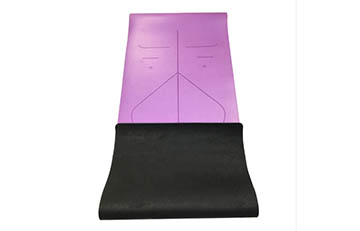 Many yogis are wondering, should the yoga mat be thicker or thinner? Is it softer or harder? Deluxe Yoga Mat Wholesalers will now introduce you to several yoga mats.
Many yogis are wondering, should the yoga mat be thicker or thinner? Is it softer or harder? Deluxe Yoga Mat Wholesalers will now introduce you to several yoga mats.
1. Foam pad
The most recommended mat for yoga practitioners is non-elastic, non-slip, unstable, and non-absorbent. It is suitable to be used as a crawling mat for babies at home to prevent moisture and cold.
2.PVC mat
One of the earliest foam pads used by everyone is micro-elastic, non-slip, non-odor-proof, non-sweat-absorbent, has a strong smell after using for a period of time, and is easy to break.
3.TPE pad
Compared with the above two types, this mat is economical, relatively elastic, it does not absorb sweat, does not deodorize, it tastes greater after a period of time, and the anti-slip effect is relatively poor.
4. Linen pad
The flexibility is good, the stability is good, it does not slip when sweating, the smell is good, and the price is higher than the above models.
5. Suede pad
It is a suede-like material with a furry surface, good hand feel, good stability, no taste, and beautiful color. But it does not slip and absorb sweat.
6. Rubber pad
(1) Artificial rubber, non-slip, sweat-absorbing, odorless, stable, and strong. High-cost performance, but the service life is short, the flat rate used is 2-3 times a week, about a year, and the price is 150 yuan.
(2) Rubber Yoga Mat
It is made of natural-collected environmentally-friendly rubber, with excellent grip and sweat absorption performance. The padded felt inner layer creates a soft cushion. After the surface of PU and polyurethane are treated at high temperatures, they are compacted without glue, so they should not bring toxic substances to the glue. Environmentally friendly polyurethane provides effective support and grip to ensure stable practice.
Cleaning method of yoga mat
1. Oil stains
Because the oil contains oleic acid, linoleic acid, linolenic acid, palmitoleic acid, palmitic acid, and stearic acid, the acidity will corrode the mat, and because the oil is less soluble than water when sweat is on the oil, it will reduce the slip resistance. Sex.
2. Exposure/Rainforest
Yoga mats made of natural rubber should not be exposed to the sun, as they will directly decompose rubber molecules, thereby reducing their service life
3. You cannot use yoga towels
4. Cleaning method
Use 300ml of clean water, neutral detergent and then wipe with a soft cloth, and then put it in a cool and ventilated place to dry.
5. Storage method
The mat storage should be rolled up, and then the way of rolling should be smooth (PU surface) on the outside, so as to prevent wrinkles on the surface of the yoga mat.
Which thickness yoga mat to choose
Moderate soft and hard, with certain support
The thickness of 4--5mm is most suitable, and there are also 3mm cushions, which are suitable for intermediate and advanced practitioners, but if you are thinner, you will still feel uncomfortable when rolling the spine.
Of course, there is also a 2mm travel yoga mat, which is for easy carrying and is not recommended for daily practice.